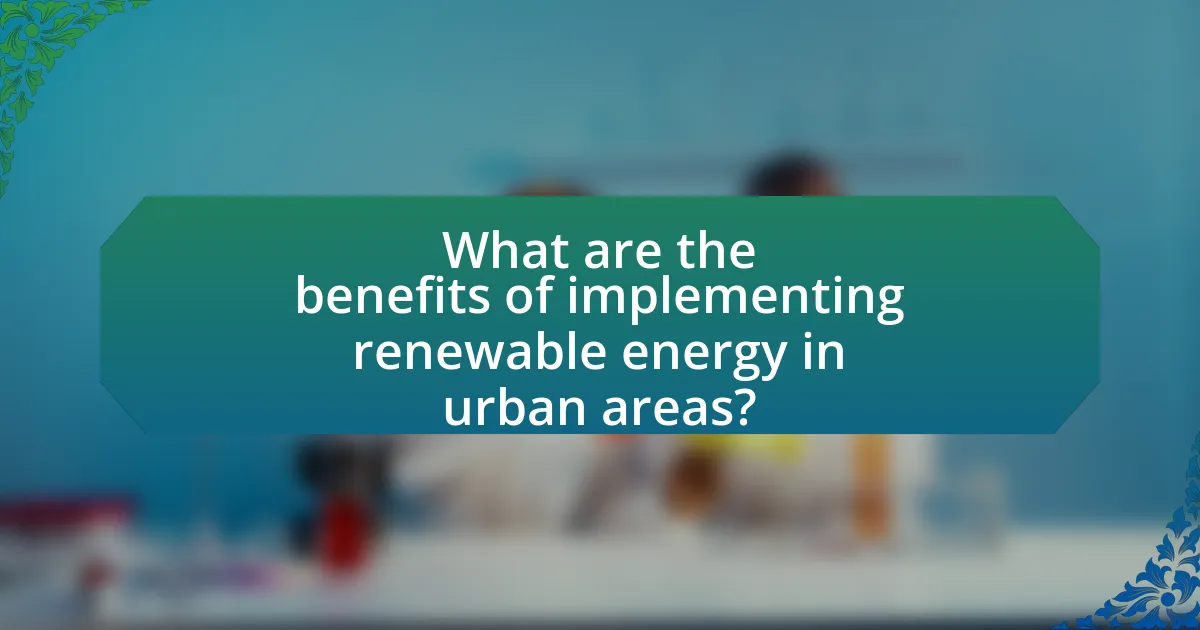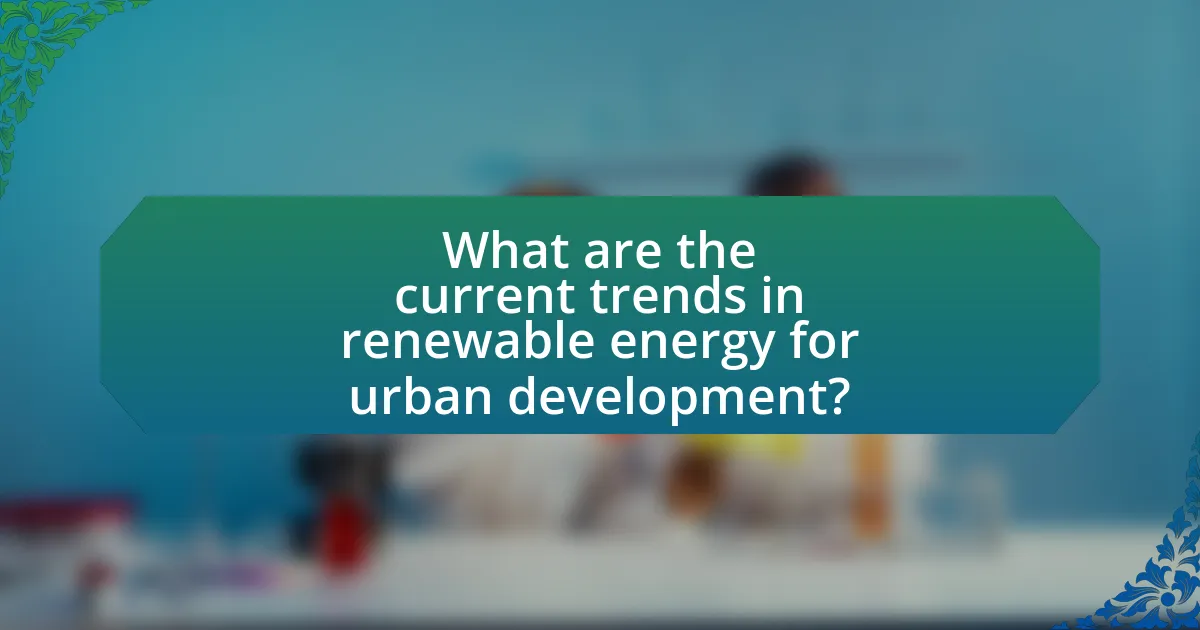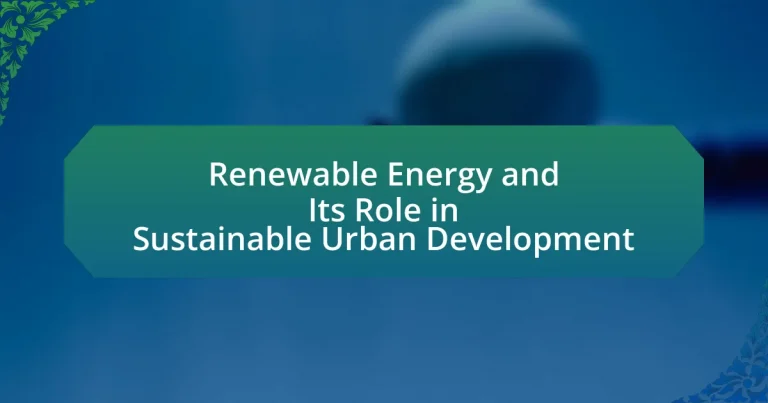Renewable energy, derived from natural sources that replenish quickly, plays a vital role in sustainable urban development by reducing greenhouse gas emissions, decreasing reliance on fossil fuels, and enhancing energy security. This article explores how renewable energy contributes to urban sustainability through various sources such as solar, wind, and biomass, and highlights the significant reductions in carbon footprints achievable through their integration. It also addresses the challenges cities face in adopting renewable technologies, the economic and social benefits of these initiatives, and current trends in urban renewable energy solutions. Furthermore, the article discusses the importance of community engagement, government policies, and best practices for effectively incorporating renewable energy into urban planning.

What is Renewable Energy and Its Role in Sustainable Urban Development?
Renewable energy refers to energy derived from natural sources that are replenished at a faster rate than they are consumed, such as solar, wind, hydro, and geothermal energy. Its role in sustainable urban development is crucial, as it helps reduce greenhouse gas emissions, decreases reliance on fossil fuels, and promotes energy security. For instance, cities that integrate renewable energy solutions can achieve significant reductions in carbon footprints; according to the International Renewable Energy Agency, transitioning to renewable energy could reduce global CO2 emissions by up to 70% by 2050. Furthermore, renewable energy systems can enhance urban resilience by diversifying energy sources and creating local jobs, thereby contributing to economic growth and social equity in urban areas.
How does renewable energy contribute to urban sustainability?
Renewable energy contributes to urban sustainability by reducing greenhouse gas emissions and promoting energy efficiency. The integration of solar, wind, and other renewable sources into urban infrastructure leads to cleaner air and lower reliance on fossil fuels. For instance, cities that implement solar energy systems can decrease their carbon footprint significantly; a study by the International Renewable Energy Agency found that solar energy could reduce urban emissions by up to 30% in some regions. Additionally, renewable energy technologies often require less water than traditional energy sources, further enhancing urban water sustainability. By fostering local energy production, renewable energy also supports economic resilience and job creation within urban areas, contributing to a more sustainable urban environment.
What are the key types of renewable energy used in urban settings?
The key types of renewable energy used in urban settings include solar energy, wind energy, and biomass energy. Solar energy is harnessed through photovoltaic panels and solar thermal systems, which are increasingly installed on rooftops and public buildings, contributing to energy independence and reducing greenhouse gas emissions. Wind energy is captured through urban wind turbines, which can be integrated into building designs or installed in open spaces, providing a clean energy source that complements other renewable technologies. Biomass energy, derived from organic materials such as food waste and agricultural residues, is utilized in urban areas for heating and electricity generation, promoting waste reduction and resource efficiency. These renewable energy sources collectively support sustainable urban development by decreasing reliance on fossil fuels and enhancing energy resilience.
How do renewable energy sources reduce urban carbon footprints?
Renewable energy sources reduce urban carbon footprints by replacing fossil fuels with cleaner energy alternatives, thereby decreasing greenhouse gas emissions. For instance, solar panels and wind turbines generate electricity without emitting carbon dioxide during operation, which significantly lowers the overall emissions associated with energy consumption in urban areas. According to the International Renewable Energy Agency, transitioning to renewable energy could reduce global carbon emissions by up to 70% by 2050, highlighting the substantial impact of these energy sources on urban carbon footprints.
Why is renewable energy essential for future urban planning?
Renewable energy is essential for future urban planning because it supports sustainable development, reduces greenhouse gas emissions, and enhances energy security. Urban areas are responsible for a significant portion of global energy consumption and carbon emissions; therefore, integrating renewable energy sources like solar, wind, and geothermal into urban infrastructure can mitigate climate change impacts. For instance, cities that adopt renewable energy solutions can decrease their carbon footprint by up to 80%, as demonstrated by the International Renewable Energy Agency’s findings. Additionally, renewable energy promotes energy independence, reducing reliance on fossil fuels and stabilizing energy prices, which is crucial for urban resilience and economic stability.
What challenges do cities face in integrating renewable energy?
Cities face several challenges in integrating renewable energy, including infrastructure limitations, financial constraints, and regulatory hurdles. Infrastructure limitations arise from the need to upgrade existing energy grids to accommodate decentralized energy sources like solar and wind. Financial constraints often stem from the high initial investment required for renewable energy technologies, which can deter municipalities from making the transition. Regulatory hurdles include complex permitting processes and outdated policies that may not support the integration of renewable energy systems. According to a report by the International Renewable Energy Agency, cities that have successfully integrated renewable energy often cite the importance of streamlined regulations and financial incentives as key factors in overcoming these challenges.
How can renewable energy improve urban resilience to climate change?
Renewable energy enhances urban resilience to climate change by providing sustainable and reliable energy sources that reduce dependence on fossil fuels. This transition decreases greenhouse gas emissions, mitigating climate change impacts such as extreme weather events and rising temperatures. For instance, cities that invest in solar and wind energy can maintain power during disruptions, ensuring critical services remain operational. According to the International Renewable Energy Agency, renewable energy can reduce urban carbon emissions by up to 70% by 2050, significantly contributing to climate adaptation and resilience strategies.

What are the benefits of implementing renewable energy in urban areas?
Implementing renewable energy in urban areas significantly reduces greenhouse gas emissions, contributing to climate change mitigation. Urban centers are responsible for approximately 70% of global CO2 emissions, and transitioning to renewable sources like solar and wind can drastically lower this figure. Additionally, renewable energy enhances energy security by diversifying energy sources and reducing dependence on fossil fuels, which are subject to price volatility. Furthermore, the adoption of renewable energy technologies can stimulate local economies by creating jobs in installation, maintenance, and manufacturing sectors. For instance, the Solar Foundation’s National Solar Jobs Census reported over 250,000 solar jobs in the U.S. as of 2019, showcasing the potential for job creation in urban settings. Lastly, renewable energy improves public health by decreasing air pollution, which is linked to respiratory diseases; studies indicate that transitioning to clean energy can lead to significant health benefits and reduced healthcare costs.
How does renewable energy impact local economies?
Renewable energy positively impacts local economies by creating jobs, stimulating investment, and reducing energy costs. The deployment of renewable energy projects, such as solar and wind farms, generates employment opportunities in construction, maintenance, and operation, contributing to local job growth. For instance, the U.S. solar industry employed over 250,000 workers in 2019, reflecting a significant increase in job creation linked to renewable energy initiatives. Additionally, investments in renewable energy infrastructure attract capital to local areas, fostering economic development and enhancing community resilience. Furthermore, renewable energy sources often lead to lower energy costs for consumers and businesses, which can increase disposable income and encourage spending within the local economy. According to the International Renewable Energy Agency, the transition to renewable energy can lead to a reduction in energy costs by up to 30% in some regions, further supporting local economic growth.
What job opportunities arise from renewable energy projects in cities?
Renewable energy projects in cities create diverse job opportunities, including roles in installation, maintenance, and management of renewable energy systems. For instance, solar panel installers and wind turbine technicians are in high demand as cities transition to solar and wind energy sources. According to the International Renewable Energy Agency (IRENA), the renewable energy sector employed over 11 million people globally in 2018, with significant growth expected in urban areas as cities adopt sustainable energy practices. Additionally, jobs in research and development, policy analysis, and energy efficiency consulting are emerging as cities seek innovative solutions to enhance their renewable energy infrastructure.
How can renewable energy reduce energy costs for urban residents?
Renewable energy can reduce energy costs for urban residents by decreasing reliance on fossil fuels and lowering electricity bills through local generation. When urban areas adopt solar panels, wind turbines, or other renewable technologies, they can produce energy on-site, which minimizes transmission losses and reduces dependency on expensive grid electricity. According to the U.S. Department of Energy, residential solar installations can save homeowners an average of $20,000 over 20 years, demonstrating significant long-term savings. Additionally, renewable energy sources often have lower operational costs compared to traditional energy sources, leading to further reductions in energy expenses for urban residents.
What social benefits does renewable energy bring to urban communities?
Renewable energy brings significant social benefits to urban communities, including improved public health, job creation, and enhanced community resilience. The transition to renewable energy sources, such as solar and wind, reduces air pollution, which is linked to respiratory diseases and other health issues; for instance, a study by the American Lung Association found that transitioning to renewable energy could prevent thousands of premature deaths annually. Additionally, the renewable energy sector is a growing source of employment; according to the International Renewable Energy Agency, the sector employed over 11 million people globally in 2018, with urban areas often benefiting from localized job creation. Furthermore, renewable energy systems can enhance community resilience by providing decentralized energy solutions that reduce vulnerability to power outages and climate impacts, fostering a sense of security and stability within urban populations.
How does renewable energy promote social equity in cities?
Renewable energy promotes social equity in cities by providing affordable and accessible energy solutions to underserved communities. This transition to renewable sources, such as solar and wind, reduces energy costs and reliance on fossil fuels, which often disproportionately affect low-income households through higher utility bills and environmental hazards. For instance, a study by the National Renewable Energy Laboratory found that community solar projects can lower energy costs by 10-20% for participants, making energy more affordable for those who may struggle to pay traditional energy prices. Additionally, renewable energy initiatives often create local jobs, contributing to economic development in marginalized areas, thereby fostering greater social equity.
What role does community engagement play in renewable energy projects?
Community engagement is crucial in renewable energy projects as it fosters local support, enhances project acceptance, and ensures that the needs and concerns of the community are addressed. Engaging the community allows project developers to gather valuable insights, which can lead to better project design and implementation. For instance, studies have shown that projects with strong community involvement experience fewer delays and conflicts, as seen in the case of the Cape Wind project in Massachusetts, where local input significantly shaped project planning. Additionally, community engagement can lead to increased investment in local economies, as residents are more likely to support initiatives that they feel a part of, ultimately contributing to the sustainability and success of renewable energy projects.

What are the current trends in renewable energy for urban development?
Current trends in renewable energy for urban development include the increased adoption of solar energy, wind energy, and energy-efficient building practices. Cities are increasingly integrating solar panels into rooftops and public spaces, with global solar capacity reaching over 1,000 gigawatts in 2021, demonstrating significant growth. Wind energy is also being harnessed in urban areas, with small-scale wind turbines being installed to complement existing energy sources. Additionally, energy-efficient building designs, such as green roofs and smart energy management systems, are becoming standard in urban planning, contributing to reduced energy consumption and lower carbon footprints. These trends reflect a broader commitment to sustainability and resilience in urban environments.
How are cities worldwide adopting renewable energy technologies?
Cities worldwide are adopting renewable energy technologies through initiatives such as solar panel installations, wind energy projects, and energy efficiency programs. For instance, cities like San Diego and Barcelona have implemented extensive solar energy systems, aiming for 100% renewable energy by 2035 and 2050, respectively. Additionally, cities like Copenhagen are investing in wind farms, which supply a significant portion of their energy needs, contributing to their goal of becoming carbon neutral by 2025. These efforts are supported by policies promoting clean energy, financial incentives for renewable projects, and public-private partnerships, demonstrating a global trend towards sustainable urban development.
What innovative renewable energy solutions are being implemented in urban areas?
Innovative renewable energy solutions being implemented in urban areas include solar energy systems, wind energy installations, and energy-efficient building designs. Cities are increasingly adopting solar panels on rooftops and integrating solar farms into urban landscapes, which can generate significant electricity. For instance, San Diego has implemented a solar energy program that aims to power 100% of its municipal operations with renewable energy by 2035. Additionally, urban wind turbines are being installed in various cities, such as Chicago, where they harness wind energy to supplement the grid. Furthermore, energy-efficient building designs, such as those following LEED certification standards, are being adopted to reduce energy consumption and promote sustainability. These solutions collectively contribute to reducing carbon footprints and enhancing energy resilience in urban environments.
How do smart city initiatives integrate renewable energy sources?
Smart city initiatives integrate renewable energy sources by implementing smart grids, which optimize energy distribution and consumption. These grids utilize advanced technologies such as IoT sensors and data analytics to manage energy flow from renewable sources like solar panels and wind turbines efficiently. For instance, cities like San Diego have adopted solar energy systems that contribute to their grid, reducing reliance on fossil fuels and lowering greenhouse gas emissions. Additionally, smart cities often incorporate energy storage solutions, such as batteries, to store excess renewable energy for later use, enhancing energy resilience and reliability. This integration not only promotes sustainability but also supports economic growth by creating jobs in the renewable energy sector.
What policies support renewable energy adoption in urban environments?
Policies that support renewable energy adoption in urban environments include financial incentives, regulatory frameworks, and public awareness campaigns. Financial incentives, such as tax credits and grants, encourage both individuals and businesses to invest in renewable technologies like solar and wind energy. Regulatory frameworks, including building codes that mandate energy efficiency and renewable energy integration, facilitate the transition to sustainable energy sources. Public awareness campaigns educate citizens about the benefits of renewable energy, fostering community support and participation. For instance, cities like San Diego have implemented a comprehensive solar energy program that combines these elements, resulting in a significant increase in solar installations and a commitment to 100% renewable energy by 2035.
How do government incentives influence renewable energy projects?
Government incentives significantly enhance the viability and attractiveness of renewable energy projects. These incentives, such as tax credits, grants, and subsidies, lower the financial barriers for developers and investors, making it easier to initiate and sustain renewable energy initiatives. For instance, the Investment Tax Credit (ITC) in the United States allows developers to deduct a substantial percentage of the cost of solar energy systems from their federal taxes, which has led to a dramatic increase in solar installations—over 90% growth from 2010 to 2020. Additionally, government-backed loans and funding programs can provide essential capital for projects that might otherwise struggle to secure financing. This financial support not only accelerates project development but also fosters innovation and competition within the renewable energy sector, ultimately contributing to a more sustainable urban development landscape.
What role do public-private partnerships play in urban renewable energy initiatives?
Public-private partnerships (PPPs) play a crucial role in urban renewable energy initiatives by facilitating collaboration between government entities and private sector companies to finance, develop, and implement renewable energy projects. These partnerships leverage the strengths of both sectors; governments provide regulatory support and public funding, while private companies contribute technological expertise and efficiency. For instance, the Global Infrastructure Facility reported that PPPs can reduce project costs by up to 30% and accelerate project timelines, making renewable energy solutions more viable in urban settings. This collaborative approach not only enhances investment in renewable energy infrastructure but also promotes innovation and sustainability in urban development.
What are best practices for cities transitioning to renewable energy?
Cities transitioning to renewable energy should prioritize comprehensive planning, community engagement, and investment in technology. Comprehensive planning involves creating a clear roadmap that outlines specific goals, timelines, and strategies for integrating renewable energy sources, such as solar and wind, into the urban energy mix. Community engagement ensures that residents are informed and involved in the transition process, fostering public support and participation. Investment in technology includes upgrading infrastructure to support renewable energy systems, such as smart grids, which enhance energy efficiency and reliability.
Evidence supporting these practices can be seen in cities like San Diego, which has committed to 100% renewable energy by 2035 through a detailed climate action plan, and Copenhagen, which has engaged its citizens in energy-saving initiatives, resulting in significant reductions in carbon emissions. These examples demonstrate that structured approaches, active community involvement, and technological advancements are essential for successful transitions to renewable energy in urban settings.
How can urban planners effectively incorporate renewable energy into their designs?
Urban planners can effectively incorporate renewable energy into their designs by integrating solar panels, wind turbines, and geothermal systems into new developments. For instance, studies show that buildings equipped with solar panels can reduce energy costs by up to 50%, while wind turbines can provide significant energy for urban areas with adequate wind resources. Additionally, planners can design neighborhoods with energy-efficient layouts that maximize natural light and ventilation, further reducing reliance on non-renewable energy sources. Implementing these strategies not only enhances energy efficiency but also contributes to the overall sustainability of urban environments.
What strategies can cities use to educate residents about renewable energy benefits?
Cities can educate residents about renewable energy benefits through community workshops, informational campaigns, and partnerships with local organizations. Community workshops provide hands-on learning experiences, allowing residents to engage directly with renewable technologies, while informational campaigns can utilize social media, newsletters, and public events to disseminate key facts about energy savings and environmental impacts. Partnerships with local organizations, such as schools and environmental groups, can amplify outreach efforts and foster a collaborative approach to education. For instance, cities like San Diego have implemented educational programs that resulted in a 20% increase in community awareness about solar energy benefits within two years.




